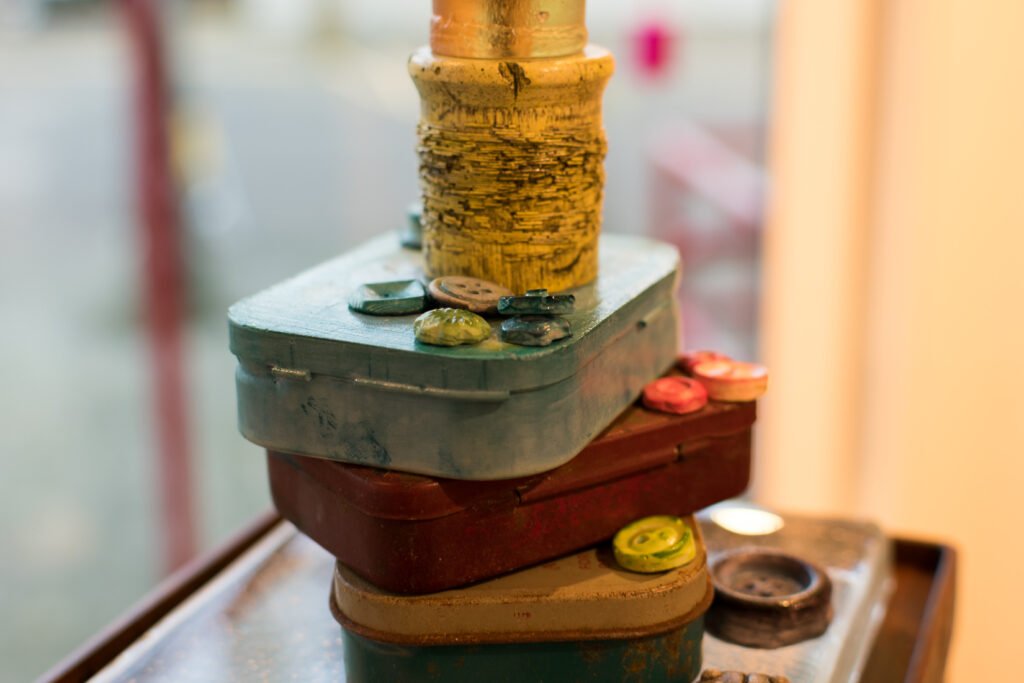
the sewing box
the sewing box
jenny judge
november 18, 2020 – january 10, 2021
ccbc shop & gallery


As an installation artist, Jenny Judge works with multiple materials and processes including glass, ceramics, mold making, plaster, cement, and fibre. Her work often centers a simple encounter, observation or event. In this case, she is focusing on the discovery of a discarded sewing box.
Jenny found the sewing box in a vintage store on a back shelf that was full of old tin boxes. The box contained spools of thread, mismatched buttons, buckles, smaller boxes of pins, wool samples, and rusty old nails. Looking closer, the owner had wrapped the saved ends of thread and rewrapped them back on to empty wooden spools, and sometimes multiple colours on to one. The assorted buttons were held in small envelopes and boxes, and organized by colour, size or shape. Judge felt a sense of responsibility for this archive and towards the work of the owner’s perseverance and frugal saving.
Like the quietness and repetitive rhythm of mending, Judge slowly began to make molds and cast elements from the sewing box: repeating, reorganizing, re-materializing, and re-imagining them. She felt that if she could cast the items in plaster or glass that they would be preserved, and the more she could replicate them, the more they would become noticed. They could develop their own voice, become present, and un-forgotten.
“Through acts of iteration the voice of the sewing box became louder, more noticeable, and more present”
This work is not only about the box, but also about everyone’s sewing boxes or button collections, and collections in general; they provoke memories and stories. The items remind Judge of the time she spent sewing with her mother, of her tins of buttons and recollecting memories, remembering the outfits they had once belonged to, and the reasons for keeping the mismatched ones just in case they were needed later.
We all have boxes like this in our lives. They honor a place of domesticity and the careful work of mending, collecting, and saving. It is about objects and their importance, about domestic labour, memories, and forgotten items. It reveals the power of materiality in the retelling of familiar stories, and places value and importance to the minute details of domestic existence.
Pieces in this installation have been created using molds from found objects, while some of the objects molded were first designed in 3D software and printed on a 3D printer (the large buttons). Most were cast directly into plaster, while others were made in to kiln-cast glass. Much of the plaster work has been dyed in layers using Procion dyes to produce colour schemes. Judge’s early memories of buttons revolve around sorting through her mother’s sewing box and organizing buttons by colour, so colour is an important component to the piece. Because the work is exhibited in the window she wanted to engage the space from the outside looking in, and also allow viewers a closer look once they entered the gallery. The three separate pedestals set up small vignettes and attend to different uses of materials: glass, plaster, rust, and dyed plaster. Individual pieces and small compositions hang in the window and offer differing interactions depending on where the viewer stands.
Jenny Judge is a contemporary craft artist working in glass, ceramics, mold-making, cement, and fiber installation. She holds an MFA in sculpture from the University of Minnesota and resides in Whistler BC. Jenny combines her materials to comment on the familiar: perhaps a fleeting observation, a hunch, or a simple encounter. She has exhibited her work within Canada, New Zealand, Australia, Japan, South Korea, France, Ireland, Scotland, and the United States.
